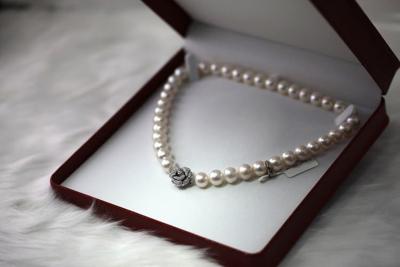
If you have a set of pearls that have been passed down to you or a family member or have come across a beautiful set of pearls of your own volition, you might want to first ensure that those pearls are genuine because pearls are something that is susceptible to being counterfeited since there is a lot of value tied in with them. You can always take your pearls to a professional jeweler but there are ways where you can examine them to spot a fake from a real one.
Fingerprint
Look at your pearls closely, even using a magnifying glass for further inspection. One of the first things that experts at https://www.purepearls.com/collections/pearl-necklaces will notice is the surface of the pearl. You should notice fingerprint-like surface ridges on them. Each pearl will differ slightly in how they appear from one to another. These qualities are specific to each individual pearl, so if you find that all your pearls have an identical look to them, or if they have a smooth to them, making them all appear the same, then you probably have a set of fake pearls on you.
Overtone Color
All pearls have an overtone color. This is extremely beautiful. Real pearls will have a sort of luster or natural shine to them. They will appear brighter or more vibrant. Fake pearls, on the other hand, will have a duller look to them, almost milky or dusty.
Luster
When looking at your pearls, in order to recognize if they are real or fake, you want to see how reflective they are. Real pearls will be reflective, and under a light source, they should reflect a bit of that light as well. Fake pearls are dull and generally won’t be reflective in the same way, if at all.
Size
The next thing would be a slight difference in the sizes of each pearl, and let me clarify that a little more extensively. If you look at a strand of pearls and you look at each individual pearl, you actually notice that each one of them has a slightly different size, shape, and texture and that is because they occur in nature. Whereas with fake pearls, each pearl would probably all look the same. They would all look exactly identical, exactly the same size as the others. The reason for the same size throughout each pearl on a fake necklace would be because fakes tend to be mass-produced, and doing so, tend to have similar features.
Shape
In addition to size, the shape of a pearl can differ between real and fake pearls. Because pearls are naturally produced, they will have minor imperfections in the shape of them. They won’t be perfectly round, although it is still possible, albeit very rare for a pearl to be perfectly round. A fake pearl is more likely to be perfectly rounded, as they will be mass-produced in a mold or machine. This should be fairly easy to compare in necklaces.
Clues In The Drill Holes
There are a few things you can look for when comparing real and fake pearls in a necklace. If you were to look at the drill holes carefully, you can identify potential fakes in how sharp the edges in the holes are. Genuine pearls will have sharp holes drilled in them while fakes may have rougher or more rounded holes as they don’t have the care put into creating the necklace. However, older pearls may have rounded edges here. It is a good idea to inspect around the holes as well for chipped paint or coating as the artificial coating will typically wear away with more use.
Temperature
The temperature of the pearls is interesting. They tend to be cold to the touch. You’ll notice this immediately putting on a pearl necklace, and feeling that cold. But as you continue to wear them, they will start to warm up, matching your body temperature. Fake pearls, on the other hand, start out and will remain at room temperature. So a way to compare real and fake pearls is to be aware of their temperature when you initial touch and hold them.
Weight
This is one of the easiest methods there is because one can immediately assess the weight of pearls. Real pearls are much heavier than fake ones. If you pick up a set of pearls and they feel light, they are most likely fake, as real ones are going to feel heavy immediately in your hand.
Teeth
A bit of an unusual way to test for genuine pearls is to take the strand and run the pearls along with your teeth. Real pearls have a gritty feeling to them, a texture that you will not be so smooth. Fakes will tend to have a smooth feeling. It is an unorthodox method of testing but another way to ensure your set of pearls are genuine and not fraud
These tips should help you determine if your set of pearls are real or not. The next time you plan to get a new set of pearls, you may try these methods to test whether they are real or fake. However, if you continue to have doubts, maybe it is best to take your pearls to be examined by a professional jeweler.




(0) comments
We welcome your comments
Log In
Post a comment as Guest
Keep it Clean. Please avoid obscene, vulgar, lewd, racist or sexually-oriented language.
PLEASE TURN OFF YOUR CAPS LOCK.
Don't Threaten. Threats of harming another person will not be tolerated.
Be Truthful. Don't knowingly lie about anyone or anything.
Be Nice. No racism, sexism or any sort of -ism that is degrading to another person.
Be Proactive. Use the 'Report' link on each comment to let us know of abusive posts.
Share with Us. We'd love to hear eyewitness accounts, the history behind an article.